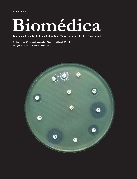Characterization of isolates of carbapenemase-producing Pseudomonas aeruginosa from seven Colombian provinces
Abstract
Introduction: Pseudomonas aeruginosa is an opportunistic pathogen that causes multiple infections in hospitalized patients. This microorganism has developed resistance to several antimicrobial agents, including carbapenems, which are considered to be the last therapeutic option against these infections. Carbapenem resistance of P. aeruginosa is mediated by different mechanisms: Carbapenemases class B (MBL) and A, alterations in the OprD expression and overexpression of the Mex efflux pump.
Objective: To describe the presence of carbapenemases in P. aeruginosa isolates from seven Colombian provinces.
Materials and methods: A total of 57 P. aeruginosa isolates were collected between September 2012 and March 2013 from national surveillance in Colombia and were sent to the Grupo de Microbiología at the Instituto Nacional de Salud (INS) for evaluation. Iidentification and antimicrobial susceptibility were confirmed through automated method (Vitek®2) and disk diffusion (Kirby-Bauer) according to the Clinical and Laboratory Standards Institute, CLSI, 2013. Phenotypic and genotypic confirmation was determined using the modified Hodge test (MHT), a synergism test using imipenem, EDTA-SMA and meropenem, and conventional PCR to detect the blaKPC, blaVIM, blaIMP and blaNDM genes.
Results: Of the 57 isolates, two showed sensitivity to carbapenems. Forty-three isolates were positive for carbapenemases with a high percentage of sensitivity to colistin (76.4%, n=42). The 43 isolates producing carbapenemases showed multiple drug resistance: 72.1% were positive in the MHT and 79.1% showed MBL synergism. PCR amplification confirmed that 33 isolates were positive for blaVIM, nine were positive for blaKPC and one isolate expressed both KPC and VIM carbapenemases. No isolates showed amplified products with blaIMP and blaNDM primers.
Conclusions: The most frequent carbapenemase was VIM, followed by KPC in an approximate ratio of 3:1.
Downloads
Some similar items:
- Karen Melissa Ordóñez, Odismar Andrea Hernández, Jorge Alberto Cortés, María José López, Gladys Alfonso, Alejandro Junca, Left-sided infective endocarditis caused by Pseudomonas aeruginosa treated medically , Biomedica: Vol. 30 No. 2 (2010)
- Andrés Leonardo González, Aura Lucía Leal, Jorge Alberto Cortés, Ricardo Sánchez, Liliana Isabel Barrero, Juan Sebastián Castillo, Carlos Arturo Álvarez, Effect of adequate initial antimicrobial therapy on mortality in critical patients with Pseudomonas aeruginosa bacteremia , Biomedica: Vol. 34 (2014): Abril, Suplemento 1, Resistencia bacteriana
- Adriana Jiménez, Alejandra Alvarado, Felipe Gómez, Germán Carrero, Claudia Fajardo, Risk factors associated with the isolation of extended spectrum betalactamases producing Escherichia coli or Klebsiella pneumoniae in a tertiary care hospital in Colombia , Biomedica: Vol. 34 (2014): Abril, Suplemento 1, Resistencia bacteriana
- Natalia Andrea Maldonado, María Isabel Múnera, Jaime Alberto López, Patricia Sierra, Carlos Robledo, Jaime Robledo, Grupo GERMEN, Trends in antibiotic resistance in Medellín and municipalities of the Metropolitan Area between 2007 and 2012: Results of six years of surveillance , Biomedica: Vol. 34 No. 3 (2014)
- Sandra Liliana Valderrama, Pedro Felipe González, María Alejandra Caro, Natalia Ardila, Beatriz Ariza, Fabián Gil, Carlos Álvarez, Risk factors for hospital-acquired bacteremia due to carbapenem-resistant Pseudomonas aeruginosa in a Colombian hospital , Biomedica: Vol. 36 (2016): Suplemento 1, Microbiología médica
| Article metrics | |
|---|---|
| Abstract views | |
| Galley vies | |
| PDF Views | |
| HTML views | |
| Other views | |


























